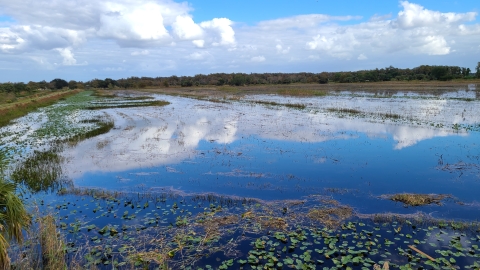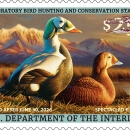What We Do
Wildlife conservation is at the heart of the National Wildlife Refuge System. It drives everything on U.S. Fish and Wildlife Service lands and waters managed within the Refuge System, from the purposes for which a national wildlife refuge national wildlife refuge
A national wildlife refuge is typically a contiguous area of land and water managed by the U.S. Fish and Wildlife Service for the conservation and, where appropriate, restoration of fish, wildlife and plant resources and their habitats for the benefit of present and future generations of Americans.
Learn more about national wildlife refuge is established to the recreational activities offered to the resource management tools used. Using conservation best practices, the Refuge System manages Service lands and waters to help ensure the survival of native wildlife species.
Management and Conservation
Fire Management
Prescribed fire is an important tool used for managing wildlife habitat. The refuge staff and partners conduct prescribed burns to enhance a variety of habitats and to control invasive and exotic plants. The refuge has a variety of vegetation types which are either dependent upon fire, susceptible to fire, or spread fire.
In Florida, fire is an important part of the natural ecology of many vegetation communities, such as pinelands and wet prairies. Fire is needed to maintain these communities and prevent the encroachment of invasive shrubs such as wax myrtle and willows. Fire also reduces the hazardous buildup of debris and dead vegetation which can fuel wildfires. Refuge staff utilizes fire to maintain healthy native vegetation communities on the refuge.
Prescribed fire is the burning of vegetation based on a prescription that takes into consideration fuel type, fuel moisture, relative humidity, air temperature, wind speed, wind direction, and other atmospheric conditions to ensure a safe and successful burn.
Fire Management Program objectives are:
To provide protection to private property and human lives against uncontrolled wildfires that may result from un-managed fire-maintained vegetative communities through vegetative fuel reduction
To provide protection to both natural and constructed Refuge resources from catastrophic wildfires through fuel reduction
To maintain biological diversity in fire-maintained plant communities by prescribed fire
To maintain habitat for Service trust resources, including endangered and threatened plant and animal species through prescribed fire.
Invasive Plant Management
The refuge uses a variety of management techniques to control invasive and exotic plants including herbicides, mechanical controls with heavy equipment, prescribed fire, hand-pulling seedlings and vines, along with biological controls when available. Invasive exotic removal work is performed by refuge staff, independent contractors, volunteers, and partner groups.
Invasive Wildlife Management
Refuge staff and volunteers conduct Cuban tree frog surveys and Everglades Invasive Reptile, Amphibian, and Mammal Monitoring Program (EIRAMMP) surveys to monitor both native and non-native wildlife and their movements on the refuge.
Visitors can report sightings of non-native species by calling 1-888-IVE-GOT1 (1-888-483-4681) or at www.IveGot1.org.
Water Management
The Everglades ecosystem depends on the natural seasonal water patterns of South Florida which rely on rain patterns. Historically, the Everglades’ dry season occurs in the winter months whereas the rainy season takes place in the summer. However, the rain does not always fall in the same, predictable way each and every year. The amount of rain that falls influences water levels in the wetlands of the Everglades. The wetlands act like a sponge, absorbing heavy rains to help prevent flooding, and slowly releasing water during dry times to combat drought.
Wading birds can catch more prey more easily when water is shallow. But as the water recedes in the dry season, prey populations can become depleted. As water levels rise in the wet season, prey can be harder to catch, but the deeper water gives prey populations a chance to rebound.
The quality or cleanliness of the water is also important. Water with chemicals enters the Everglades from canals from our cities and from farm fields that produce our food crops. These chemicals, called nutrients, affect how fast or slow some of the plants in the refuge will grow. Too many nutrients can cause non-native plants to grow and crowd out the native ones. Even if a plant is “native” or belongs in the system, excessive amounts of these nutrients can make certain plants grow much too fast which would consequently disrupt the balance of the ecosystem.
Tiny organisms called periphyton are the lowest level of the food chain here in the refuge. Periphyton is a spongy looking mat of algae and bacteria. Fish and invertebrates, like crayfish and apple snails, eat the periphyton. They, in turn, become food for all the reptiles, amphibians, birds and mammals that live here. The kind of periphyton found in the sloughs and open water of our refuge is not found anywhere else in the entire Everglades ecosystem. The quantity and quality of the water in our refuge affect these periphyton and all the animals that depend on them.
Our Services
Special Use Permits
Some commercial, recreational, or research activities are allowed on national wildlife refuges only with a special use permit issued by the local office, and are subject to specific conditions and fees. This permit requirement is meant to ensure that all activities at the federal site are compatible with the refuge’s congressionally mandated wildlife conservation goals. Special use permits may limit the scope, timing and location of the activity, as determined by the refuge where the activity would take place.
Prospective permit holders may fill out the corresponding permit application, sign it, and return it to the refuge for processing. Please submit by email to armloxahatchee@fws.gov. The permit is not valid until approved and signed by a refuge official. Allow for 30 working days to process the permit.
All Special Use Permit applications can be found by clicking on this link.
Commercial Activities Special Use Application
For commercial activities such as guiding hunters, anglers, or other outdoor users; for commercial filming (audio, video, and photographic products of a monetary value).
Research and Monitoring Special Use Application
For research and monitoring activities by students, universities, or other non-FWS organizations.
General Activity Special Use Application
For fishing tournaments, airboat use permits, and other miscellaneous events or any activity not mentioned elsewhere on this page.
Related: Filming Activities in the National Wildlife Refuge System
Our Projects and Research
Pythons and Python Management in South Florida
Burmese pythons (Python molurus bivittatus) are large constrictor snakes native to Southeast Asia that have been introduced to southern Florida through the exotic pet trade. Pythons have likely been established in Florida since the 1980s and are currently distributed over a vast area of public and private lands, crossing multiple jurisdictions south of Lake Okeechobee to the Upper Keys and from the east and west coast of Florida. By far, the areas of the Everglades to the south and southwest of the Arthur R. Marshall Loxahatchee National Wildlife Refuge (Refuge) have the greatest concentration of pythons. Pythons are a threat to native ecosystems, human health and safety, Everglades restoration efforts, and more. Their impacts include direct depredation of native wildlife, competition for resources, and introduction of novel pathogens and parasites. A scientific publication noted a 90% decrease in mammal populations seen on wildlife surveys in Everglades National Park, likely the result of predation by pythons. Despite control efforts undertaken by land managers and partners since the early 2000s, the python population continues to expand in Florida.
Florida Python Control Plan
To better manage the continued expansion of the Burmese python population, 15 State, Federal and local agencies, Tribes, and one non-governmental organization embarked on a three-year collaborative effort to develop a management plan for Burmese pythons; the Florida Python Control Plan(FPCP). The FPCP stresses the importance of a unified approach and adaptive management strategy to control invasive Burmese pythons. The U.S. Fish and Wildlife Serviceis an active partner in the FPCP Working Group, and supports the objectives and action items detailed in the plan.
Python Contractor Removal Programs
Although only one Burmese python has been officially recovered on the Refuge, over 21,000 pythons have been removed from the Florida ecosystem since the mid-1990s. In 2017, in response to the threat to native wildlife especially to threatened and endangered species, the Florida Fish and Wildlife Conservation Commission (FWC) and the South Florida Water Management District (SFWMD) established two paid contractor removal programs, the Python Action Teams Removing Invasive Constrictors and the Python Elimination Program respectively. Under these two unified programs, contractors receive an hourly ‘search’ rate plus an incentive payment for each snake removed based upon the length of the python. Contractors also receive a bonus payment for finding a python nest containing eggs. These two programs alone have combined to remove over 13,000 pythons on the Everglades landscape since their creation.
Refuge Python Control Efforts
Over the last five years the Refuge has increased its monitoring efforts for invasive Burmese pythons in response to the increasing number of reports. Refuge biologists have installed real-time camera traps on 20 tree islands in the refuge marsh interior to detect the presence or absence of native mammals and other wildlife including pythons. If, for example, the numbers of mammals detected by cameras on tree islands steadily or significantly decreases over time, it could indicate that the python population on the Refuge is increasing. Starting in 2021, the Refuge hired interns specifically to conduct python surveys on Refuge lands and levees and, if necessary, to respond rapidly to reports of large constrictors on the Refuge and on adjacent lands. In June of 2022, a verbal agreement was established with FWC and the SFWMD permitting their paid python contractors to access eight south Florida NWRs including the Refuge to survey for and remove pythons. As of January 1, 2024, no additional pythons have been removed on the Refuge.
For more information on Burmese pythons and python management in south Florida, please visit the Florida Python Control Planwebsite.
Law Enforcement
"Through education and enforcement we protect our employees, volunteers, and visitors; safeguard the public’s investment in facilities and equipment; and protect the integrity of the habitat and the wildlife resources of the National trust resource which is the 150 million acre National Wildlife Refuge System.” - Mission statement of National Wildlife Refuge System Law Enforcement program.
Laws and Regulations
Key legislation that guides the management of Arthur R. Marshall Loxahatchee National Wildlife Refuge can be found on our Laws and Regulations page.






